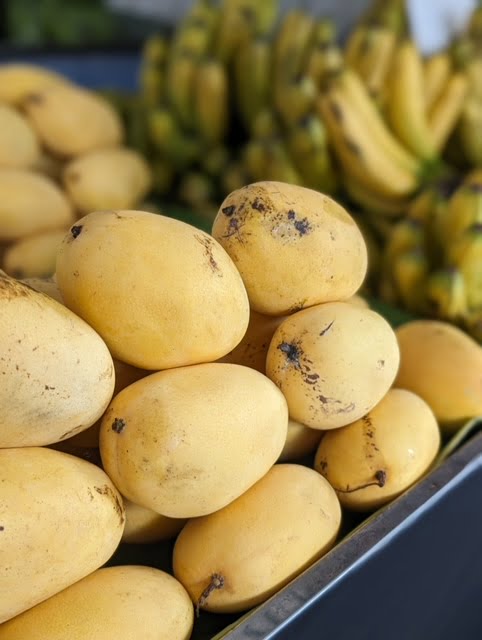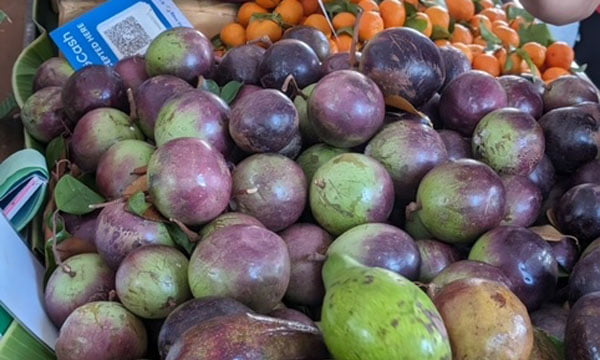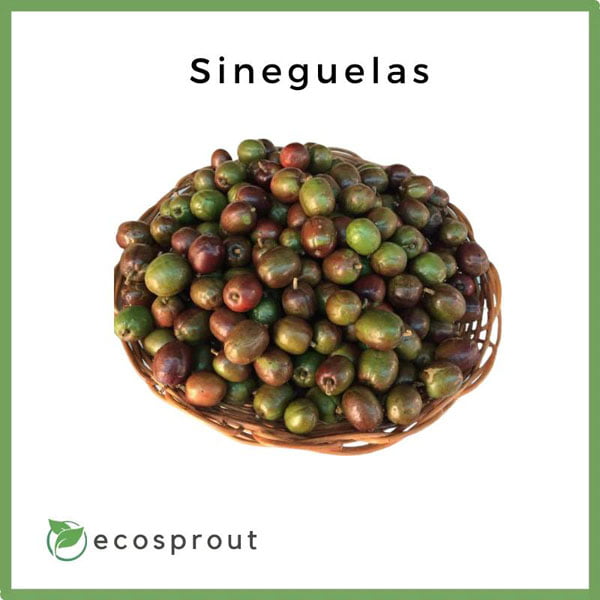Being a tropical country, the Philippines is home to a huge variety of fruits, some of which are known internationally to be the best. Whether you’re visiting the country for the first time or are coming home after years of being abroad, there’s nothing like the taste of sweet ripe mango—especially if it’s from Guimaras—or a cooling sip of fresh buko juice while you’re vacationing in one of the country’s many beach destinations.
We’ve listed below fruits that you shouldn’t miss out on anytime you’re in the Philippines, and especially during the summer months of March to May—including the best place to buy them, how they taste, and a few local secrets to enjoy eating them to the fullest. Also check out Part 2 here, where we list fruits available after summer: from the wet months of June to October or November to the cooler months from December to February.
Available all year round
1. Saging (Banana)
Best season: All year round
Best place to buy: Available everywhere, depending on what variety you want
Chances are you’ve eaten Filipino cavendish bananas from Dole or Del Monte outside of the Philippines at some point in your life. While these are spotless, perfectly shaped, and sweet, there’s a lot more that the motherland has to offer. There are so many banana varieties in the Philippines that it will take another full article to discuss them, so we’ll highlight two of the most popular.
Lakatan is the variety that you’ll often find in Metro Manila. It’s soft but firm, easy to peel, and has just the right amount of sweetness. Don’t be afraid to pick ones with a few dark spots, as often, their ripeness is just right. Lakatan can be found everywhere, from supermarkets to your suking tindahan (small stores).
Another is saba, which is both a viand and a dessert. Much smaller and pudgier than lakatan, this can be eaten as is or cooked. The saba, with peppercorn-sized seeds that you need to watch out for, usually shines as a dessert or snack. You’ll find them sold by rolling vendors or food stalls, skewed and fried with a beautiful crust of brown sugar as banana-que (taken from “barbecue,” which, more than the process of cooking, references to it being skewered). They’re also sold as saba con yelo (saba with ice): saba boiled in sugar and boba (also a dish in itself called minatamis na saging or “sweetened bananas”) and packed with crushed ice in a glass topped by a splash of evaporated milk. There’s also ginataang saging, which is saba cooked in warm coconut milk with sticky rice balls and boba.
Banana varieties available in the Philippines also include latundan (similar but smaller than lakatan) and señorita (even smaller than latundan and has very thin and peelable skin), among many others.
2. Buko (Coconut)
Best time to buy: All year round
Best place to buy: Available everywhere
Being a tropical island, coconuts are everywhere. Each part of the coconut tree has its use: The palms are made into bags and even walls of kubo; the stalks can be turned into walis tingting; the trunk is a very durable type of wood that can be used in building homes and furniture; and the youngest parts of the palm are eaten as ubod.
The fruit itself is both edible and useful. When green and fresh, chop off the top part for its water and soft flesh. It’s called niyog when brown and aged. Its tough flesh is usually grated as topping for malagkit or sticky rice desserts, or pressed for its gata or milk. Gata is such an integral part of Philippine cuisine and is used in many dishes.
Coconuts are available in most Filipino restaurants and in markets and groceries in the country. Locals, however, would opt for coconuts sold by ambulant vendors who chop them fresh for you to drink as these are infinitely cheaper than those offered in established places. If you’re willing to try and if there’s one who passes in your area, the best time to buy is early in the morning—around 7:00 to 9:00AM—as their carts are still full and you get to pick the best, most juice-filled ones to drink.
3. Pineapple
Best season: Available all year round, peaking between April and June
Best places to get them from: Tagaytay City in Luzon and Bukidnon in Mindanao
The pineapples (called “pinya” locally) isn’t only a huge part of Filipino cuisine. Pineapples in the Philippines are actually considered some of the sweetest in the world. Tagaytay City in Luzon has many pineapple farms, some of which are even located in and owned by many of the convents dotting the area. There are farms that offer tours, and it’s easy enough to ask locals how to go about scheduling one.
Tagaytay is also home to a restaurant that serves home-brewed beer made from pineapples. Papa Bolo, which is located at Crisanto De Los Reyes Avenue corner Tagaytay-Nasugbu Road, offers bar chow and six different types of beer, with the Piña Niña being the star of the show. They’re open daily except Tuesdays.
Bukidnon is another great place to explore pineapples, as it’s where Del Monte’s plantation is located. Nestled within Camp Phillips, which is a 45-minute drive from the nearby city of Cagayan de Oro, you can tour the property, enjoy different ways pineapples are prepared, and even pick a Del Monte pineapple yourself. Just remember that you’ll have to finish the fruit within the premises as you’re not allowed to take it out.
If you’re not able to visit these destinations, there are always pineapples in markets and groceries. Tip: The smallest ones with golden-yellow eyes are often the sweetest!
4. Bayabas (Guava)
Best time to buy: Available all-year round, but best bought in August to September
Best place to buy: Available everywhere
Not to be mistaken for the large hybrid guapples, guavas are small, green fruits that can be eaten raw, skin and all. These have an interesting tangy taste with a texture that’s slightly similar to pears. They’re often used as a souring agent in sinigang as well as in jams.
Guapples, on the other hand, are bigger hybrids with a bit more crunch. These are more often eaten as is instead of being used in savory dishes. As both are very common in the Philippines and are backyard fruits, they’re available in many markets and groceries.
Available during summer (March to May)
5. Mangga (Mango)
Best season: During summer, from March to June
Best place to buy: Guimaras in Visayas

As the Philippines is a tropical country, mango trees are literally everywhere. The most common variety in the country is the Indian mango with thick, green skin, whether it’s ripe or not. You can test for ripeness by slightly pressing on the flesh or smelling it. These mangoes are eaten in all stages of ripeness—when it’s young, it’s often very sour and eaten with bagoong or fish paste. It’s the same when it’s manibalang or just almost ripe, with hints of sweetness and a nice, juicy crunch. When it’s ripe, it can be eaten by biting the tip of the fruit with your teeth and simply pulling the skin off and enjoying its flesh.
If you want to experience really sweet and delicious mangoes, you’ll want to look for those from Guimaras in Western Visayas, which is a quick boat ride from Iloilo City. They’re so famous that they’re even celebrated yearly during the “Manggahan Festival,” which usually happens from May 11 to 22, although the dates sometimes vary. Despite the crowd, this is when you should go to Guimaras if you want to experience not just the sweetest mangoes, but also the culture that was built around it.
On the regular, Guimaras mangoes are available in weekend markets such as the Salcedo Market. Dizon Farms also has them available online, but do remember that the best ones are available during summer.
6. Papaya
Best time to buy: March to July
Best place to buy: Available everywhere

Papaya is often eaten as a snack and a dessert, but it’s also a common ingredient used in tinolang manok or clear chicken soup. According to the Bureau of Agriculture and Fisheries Standards, there are currently seven commercial varieties of papaya sold for human consumption in the Philippines, which include Cavite Special, Morado, Solo, Sinta, Cariñosa, Red Lady, and Red Royale.
It’s easy to find papaya as they’re sold in small stores, wet and weekend markets, and in supermarkets where they’re usually offered already sliced or diced. The best way to enjoy papaya as a refreshing snack, however, is by buying one whole fruit (make sure it’s almost fully yellow and soft to the touch so you know it’s ripe), putting it in the fridge, and after it’s cooled, slicing it vertically, removing the black seeds in the middle. Some even enjoy it with a squeeze of calamansi.
7. Langka (Jackfruit)
Best time to buy: March to May
Best place to buy: Leyte and other places in Visayas

If you’ve been in the country for a while, chances are you’ve already tasted langka (jackfruit) within the first two days of your visit. If you’ve been treated to a traditional halo-halo, langka is the sweet, somewhat thready, yellow fruit that adds depth to the dessert. It’s also included in any respectable turon (sweet banana wrapped in rice paper, dipped in sugar, and fried).
Langka has always been commonly available in all parts of the country as it’s considered a backyard crop, but in recent years, Eastern Visayas regions have been focusing on reestablishing jackfruit plantations that were destroyed by the Typhoon Yolanda (Haiyan) in 2013. Abuyog, Leyte is known for its sweet Eviarc jackfruit variety that are perfect not just for eating chilled and raw, but also for processing as dried snacks and candies. If you’re looking for a whole jackfruit, this is the best place to source for it. Supermarkets also offer them, but often already sliced, picked, and packed.
8. Kaimito (Star Apple)
Best time to buy: March to May
Best place to buy: Merkado Supermarket in UP Town Center in Metro Manila, wet and dry markets everywhere

Kaimito, also known as “star apple,” is a fruit with its flesh and seeds arranged like a star. It can either be green or deep violet, but both variants have extremely sweet flesh that is usually eaten raw. Some put it in a bowl and mix it with ice-cold milk for a refreshing snack. This backyard fruit is easier to buy in wet and dry markets, although there is also an abundance of it in groceries during its peak season.
9. Duhat
Best time to buy: March to July
Best place to buy: Wet and dry markets during its season, online

Duhat trees were rampant in PH back in the 1980s. The duhat tree has a thick trunk and roots and would produce clusters upon clusters of fruit. The fruit itself is a deep purple that stains your fingers and clothes (careful, it doesn’t come off) and has a bouncy flesh that’s both sweet and tangy, almost like a wild berry. It’s best eaten after being refrigerated and sprinkled with or dipped in rock salt. Duhat is available in markets during the summer months, although they are harder to come by these days. Your best bet is to look for produce stores online such as Ecosprout.
10. Kamatsile
Best time to buy: February to May
Best place to buy: Iloilo, but available everywhere
Kamatsile is so common in the Philippines that there’s a word for it in different provinces: “kamatsile” in Metro Manila and in Central Luzon (including Pampanga), “kamunsil” in Iloilo, and “damortis” in Ilocos, among others. It’s also called “Manila tamarind” and has a uniquely addictive sweet-tart taste. If you want a harvest that’s on the sweeter side, get them from San Joaquin, Iloilo, which is a known producer of this fruit. Kamatsile is more often seen in wet and dry markets than in grocery stores.
11. Sineguelas (Spanish Plum)
Best time to buy: April to June
Best place to buy: Manaoag in Pangasinan, Batangas, Iloilo, and Cagayan de Oro

Sineguelas is also known as “Spanish plum,” as it was brought into the country by Spanish colonizers centuries ago. This round, purplish green fruit is eaten with its skin, which may be tough to bite into, but breaks into a beautiful yellow flesh that is sweet and sometimes slightly tart. It’s usually sprinkled with salt when eaten. This fruit is quite rampant in wet and dry markets during its season, and is a popular pasalubong from the pilgrimage town of Manaoag in Pangasinan.
Is your favorite fruit to eat in the Philippines not on this list? Check out Part 2, where we list fruits available after summer: from the wet months of June to October or November to the cooler months from December to February. Are there other fruits you want us to write about? Tell us in the comments of our Facebook and Instagram posts!
